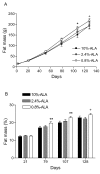A low alpha-linolenic intake during early life increases adiposity in the adult guinea pig
- PMID: 20205840
- PMCID: PMC2825514
- DOI: 10.1186/1743-7075-7-8
A low alpha-linolenic intake during early life increases adiposity in the adult guinea pig
Abstract
Background: The composition of dietary fatty acids (FA) during early life may impact adult adipose tissue (AT) development. We investigated the effects of alpha-linolenic acid (ALA) intake during the suckling/weaning period on AT development and metabolic markers in the guinea pig (GP).
Methods: Newborn GP were fed a 27%-fat diet (w/w %) with high (10%-ALA group), moderate (2.4%-ALA group) or low (0.8%-ALA group) ALA content (w/w % as total FA) until they were 21 days old (d21). Then all animals were switched to a 15%-fat diet containing 2% ALA (as total FA) until 136 days of age (d136).
Results: ALA and docosapentaenoic acid measured in plasma triglycerides (TG) at d21 decreased with decreasing ALA intake. Total body fat mass was not different between groups at d21. Adipose tissue TG synthesis rates and proliferation rate of total adipose cells, as assessed by 2H2O labelling, were unchanged between groups at d21, while hepatic de novo lipogenesis was significantly 2-fold increased in the 0.8%-ALA group. In older GP, the 0.8%-ALA group showed a significant 15-%-increased total fat mass (d79 and d107, p < 0.01) and epididymal AT weight (d136) and tended to show higher insulinemia compared to the 10%-ALA group. In addition, proliferation rate of cells in the subcutaneous AT was higher in the 0.8%-ALA (15.2 +/- 1.3% new cells/5d) than in the 10%-ALA group (8.6 +/- 1.7% new cells/5d, p = 0.021) at d136. AT eicosanoid profiles were not associated with the increase of AT cell proliferation.
Conclusion: A low ALA intake during early postnatal life promotes an increased adiposity in the adult GP.
Figures



Similar articles
-
The effects of dietary alpha-linolenic acid compared with docosahexaenoic acid on brain, retina, liver, and heart in the guinea pig.Lipids. 1999 May;34(5):475-82. doi: 10.1007/s11745-999-0387-3. Lipids. 1999. PMID: 10380119
-
The influence of dietary linoleic and alpha-linolenic acid on body composition and the activities of key enzymes of hepatic lipogenesis and fatty acid oxidation in mice.J Anim Physiol Anim Nutr (Berl). 2007 Feb;91(1-2):11-8. doi: 10.1111/j.1439-0396.2006.00636.x. J Anim Physiol Anim Nutr (Berl). 2007. PMID: 17217386
-
Increased alpha-linolenic acid intake increases tissue alpha-linolenic acid content and apparent oxidation with little effect on tissue docosahexaenoic acid in the guinea pig.Lipids. 2000 Apr;35(4):395-400. doi: 10.1007/s11745-000-537-7. Lipids. 2000. PMID: 10858024
-
Single frequency intake of α-linolenic acid rich phytosterol esters attenuates atherosclerosis risk factors in hamsters fed a high fat diet.Lipids Health Dis. 2016 Feb 3;15:23. doi: 10.1186/s12944-016-0185-8. Lipids Health Dis. 2016. PMID: 26843021 Free PMC article.
-
Transfer rate of α-linolenic acid from abomasally infused flaxseed oil into milk fat and the effects on milk fatty acid composition in dairy cows.J Dairy Sci. 2012 Sep;95(9):5276-5284. doi: 10.3168/jds.2012-5415. J Dairy Sci. 2012. PMID: 22916932
Cited by
-
The effects of dietary fatty acids in the physiological outcomes of maternal high-fat diet on offspring energy homeostasis in mice.J Dev Orig Health Dis. 2020 Jun;11(3):273-284. doi: 10.1017/S2040174419000540. Epub 2019 Sep 26. J Dev Orig Health Dis. 2020. PMID: 31556363 Free PMC article.
-
Regulation of Adipose Tissue Biology by Long-Chain Fatty Acids: Metabolic Effects and Molecular Mechanisms.J Obes Metab Syndr. 2022 Jun 30;31(2):147-160. doi: 10.7570/jomes22014. Epub 2022 Jun 13. J Obes Metab Syndr. 2022. PMID: 35691686 Free PMC article. Review.
-
Synergism of α-linolenic acid, conjugated linoleic acid and calcium in decreasing adipocyte and increasing osteoblast cell growth.Lipids. 2013 Aug;48(8):787-802. doi: 10.1007/s11745-013-3803-5. Epub 2013 Jun 12. Lipids. 2013. PMID: 23757205
-
Fats & fatty acids in Indian diets: Time for serious introspection.Indian J Med Res. 2016 Oct;144(4):507-514. doi: 10.4103/0971-5916.200904. Indian J Med Res. 2016. PMID: 28256458 Free PMC article. Review.
References
-
- Gardner DS, Tingey K, Van Bon BW, Ozanne SE, Wilson V, Dandrea J, Keisler DH, Stephenson T, Symonds ME. Programming of glucose-insulin metabolism in adult sheep after maternal undernutrition. Am J Physiol Regul Integr Comp Physiol. 2005;289:R947–R954. - PubMed
LinkOut - more resources
Full Text Sources
Miscellaneous

